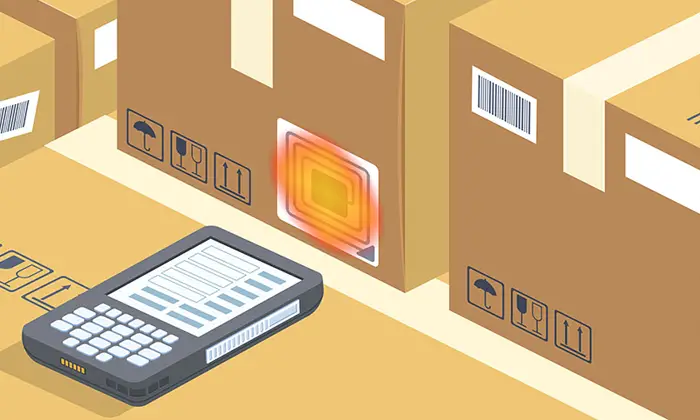Amongst all the location tracking technologies in the market, Radio Frequency Identification is a groundbreaking innovation! RFID technology has empowered businesses with the ability to streamline their processes, mitigate losses, and increase overall efficiency. In fact, RFID is also one of the key technologies in the Internet of Things.
The Anatomy Of An RFID System
RFID architecture is actually composed of a number of crucial components or technologies including:
- A range of hardware selection including:
- Fixed, handheld, USB, or other types of RFID Readers (also called Interrogators) that can read and record tags within their range.
- One or more Tag Antennas and Reader Antennas that facilitate identification of tags from a remote distance and decrypt the waves into comprehensible digital information.
- RFID Tags or information embedded chips, which can be either Active or Passive.
- A specialized RFID Software application that is compatible with both the hardware items and the tags. Also referred to as Middleware, the software processes the data transferred from the reader to the system and offers actionable insights.
A number of significant advancements in RFID technology have made it even more accessible, making RFID a prominent choice for location tracking in businesses. RFID tags (both active and passive ones) are now available in highly economical ranges, and the readers also provide longer read ranges! Several industries such as transportation, retail, healthcare, and defense are employing RFID technology for its data accuracy and tremendous ROI value.
An RFID System
Keeping track of both fixed and mobile assets in real time is important for virtually every business. However, the technology best-fit for the job comes in two flavors: Active RFID and Passive RFID. Like any innovation that enters the market, the confusion around its viability and the complex choices it presents can be perplexing for anyone!
If you are also seeking some clarity on how similar or different active and passive tags are, here’s some insight to help you comprehend which of the two radio frequency technologies is right for your application.

Active RFID Vs. Passive RFID
In both Active and Passive RFID technologies, a tag and a reader communicate through radio frequencies. However, each has a different method of powering the tag. Simply put, an active tag has an internal power source (usually a battery) for its RF communication whereas a passive tag does not have its own source of power and depends on the RF energy transferred from the reader for activation. This explains why passive tags are smaller in size and more expensive than active tags.
Once the tag receives the signal, it generates a response and sends it back to the reader on a different frequency level. This response generation process is called backscatter. Once the reader detects the backscatter, the change in the electromagnetic or RF wave, the interpreted information is presented to you via the RFID software.
Active RFID
An active RFID tag (also known as a beacon) is composed of a battery and an active transmitter, allowing it to transmit its own signal. Since active tags don’t depend on the reader signal to broadcast a response, the tag in an active RFID system can capture even the low-frequency signals and generate a response of a much stronger frequency. As an active tag is constantly active, the response time is shorter, and the active tag can be programmed to send periodic beacon messages to the reader, or in some cases even other tags.
Passive RFID
The battery-free passive RFID tags depend on the electromagnetic waves to draw power and generate a response. A passive tag needs certain signal strength for activation. The farther the reader is, the weaker will be the signal, which will in turn impair the ability of the tag to draw ample power. Both the reader and the tag have to be present within the read zone to communicate efficiently.
A Comparative Analysis
Application & Range:
Passive RFID system is a good choice for item-level tracking over short ranges. Inventory management, goods tracking, near-field card access, asset or document location, and theft prevention are some of the areas where you can significantly benefit from passive tags. The read range of passive tags is not more than ten meters. Hence, the scaling of an entire system can be done by employing a few readers at certain distances.
If you require monitoring for your entire commercial building or long-distance transits, an active RFID system is your best bet! Active tags usually have a scalability of over 100 feet distances. Thanks to the excellent read ranges of the readers and large memory of tags due to an onboard power source, active tags can be either read-only or read/write with higher storage capacity. You can also modify the data stored in tags easily by the reader. Active tags are ideal for situations that demand long-range scanning such as access control, equipment monitoring (e.g., the service status), as well as logistics.
Cost Of Tags:
If the cost of tags greatly influences your decision of investing in RFID technology, passive tags will fit right in your budget. Passive RFID systems generally have lesser technologies including a reader, antenna, and tags. The system can function efficiently at all frequency levels within its limited read zone.
Longevity:
Since passive RFID tags don’t have a battery or a transmitter, they are smaller in size, lighter in weight, and are easier to attach. Such favorable qualities of passive tags make them virtually last forever.
On the flip side, active tags have a lifespan of three to five years. In certain applications, active tags can even last up to ten years. Although active tags rank lower than the passive ones on the scale of longevity, actives tags boast a better battery life than many other real-time location systems (RTLS) such as ultra wide-band and WiFi.
Environmental Constraints:
Passive tags can withstand high temperatures and challenging, rugged environments. Since passive tags don’t carry batteries, it is easy to seal them for successful application in tough cases or surfaces which are otherwise difficult with active tags. However, technological advancements have improved the functional efficiency of active tags in various harsh environments. RFID tags can be designed to your specific situation at economical prices to deliver the performance you want!
Scalability and functionality are two major criteria that define your choice of RFID tag. You can even choose to have both active and passive RFID technologies work in tandem according to your tracking requirements.
If you are considering deploying an RFID system to manage your business operations, contact Trakaid for a professional consultation service today. We boast a long-standing experience in deploying RFID technology to help businesses optimize their assets for better performance and longevity.
